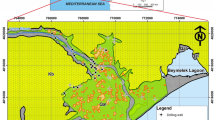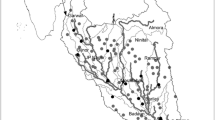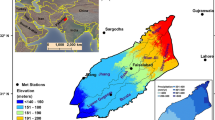Abstract
Conjunctive use of water has an increasingly important role in dealing with climate change impacts in several regions. Water resources are holistically managed by harvesting surplus surface water into aquifers during wet season and extracting it for supply in dry season. This study aims to apply integrated hydrological modeling to evaluate groundwater recharge approaches for conjunctive use of water under future climates. The study area is Yom and Nan River basins, northern Thailand, which always suffers climatic extreme events. Surface water-groundwater regime is simulated by using SWAT-MODFLOW model under minimum and maximum greenhouse gas emission scenarios as the Representative Concentration Pathways (RCPs) 2.6 and 8.5, respectively. Managed aquifer recharge (MAR) method is applied in simulation to represent the conjunctive use of water. Results demonstrate that about 14%, mainly plains, of watershed area have high suitability for managing aquifer recharge. Almost 2000 recharge wells constructed in high suitable areas near existing groundwater pum** wells provide that, by recharging groundwater at 550–700 m3/day in the upper and 820–900 m3/day in the lower watershed areas during 2021–2030 under RCPs 2.6 and 8.5, annual groundwater storage is more added 22 × 106 m3 including 530 × 106–570 × 106 m3 decrease in surface water. During 2031–2040 under RCP 2.6 (8.5), a recharge rate at 1200–1400 (1000–1150) m3/day in the upper area and 1650–1800 (1400–1500) m3/day in the lower area can increase a 48 × 106 m3 of groundwater storage and reduce a 940 × 106–1120 × 106 m3 of surface water. Outputs can enhance information for holistic water management responding to climate change adaptation.









Similar content being viewed by others
Data and materials availability
The data are available by the corresponding author upon reasonable request.
References
Abbas, N., Wasimi, S. A., Al-Ansari, N., & Baby, S. N. (2018). Recent trends and long-range forecasts of water resources of northeast Iraq and climate change adaptation measures. Water, 10(11), 1562. https://doi.org/10.3390/w10111562
Aliyari, F., Bailey, R. T., & Arabi, M. (2021). Appraising climate change impacts on future water resources and agricultural productivity in agro-urban river basins. Science of the Total Environment, 788, 147717. https://doi.org/10.1016/j.scitotenv.2021.147717
Aliyari, F., Bailey, R. T., Tasdighi, A., Dozier, A., Arabi, M., & Zeiler, K. (2019). Coupled SWAT-MODFLOW model for large-scale mixed agro-urban river basins. Environmental Modelling and Software, 115, 200–210. https://doi.org/10.1016/j.envsoft.2019.02.014
Arnold, J. G., Srinivasan, R., Muttiah, R. S., & William, J. R. (1998). Large area hydrologic modeler and assessment part I: Model development. Journal of the American Water Resources Association, 34, 73–89. https://doi.org/10.1111/j.1752-1688.1998.tb05961.x
Arunrat, N., Wang, C., Pumijumnong, N., Sereenonchai, S., & Cai, W. (2017). Farmers’ intention and decision to adapt to climate change: A Case study in the yom and nan basins, phichit province of Thailand. Journal of Cleaner Production, 143, 672–685. https://doi.org/10.1016/j.jclepro.2016.12.058
Bailey, R. T., Rathjens, H., Bieger, K., Chaubey, I., & Arnold, J. G. (2017). SWATMOD-Prep: Graphical user interface for preparing coupled SWAT-MODFLOW simulations. Journal of the American Water Resources Association, 53(2), 400–410. https://doi.org/10.1111/1752-1688.12502
Bailey, R. T., Wible, T. C., Arabi, M., Records, R. M., & Ditty, J. (2016). Assessing regional-scale spatio-temporal patterns of groundwater-surface water interactions using a coupled SWATMODFLOW model. Hydrological Processes, 30(23), 4420–4433. https://doi.org/10.1002/hyp.10933
Chunn, D., Faramarzi, M., Smerdon, B., & Alessi, D. S. (2019). Application of an integrated SWAT-MODFLOW model to evaluate potential impacts of climate change and water withdrawals on groundwater-surface water interactions in west-central Alberta. Water, 11(1), 110. https://doi.org/10.3390/w11010110
Cook, B. I., Mankin, J. S., Marvel, K., Williams, A. P., Smerdon, J. E., & Anchukaitis, K. J. (2020). Twenty-first century drought projections in the CMIP6 forcing scenarios. Earths Future. https://doi.org/10.1029/2019EF001461
Department of groundwater resources. (2020). Managed aquifer recharge approaches in Thailand (in Thai). Department of groundwater resources. Retrieved 11 April 2022 from http://www.dgr.go.th/th/newsAll/261/2965
Dillon, P., Stuyfzand, P., Grischek, T., Lluria, M., Pyne, R. D. G., Jain, R. C., Bear, J., Schwarz, J., Wang, W., Fernandez, E., Stefan, C., Pettenati, M., Gun, J. V. D., Sprenger, C., Massmann, G., Scanlon, B. R., Xanke, J., Jokela, P., Zheng, Y., … Sapiano, M. (2019). Sixty years of global progress in managed aquifer recharge. Hydrogeology Journal, 27, 1–30. https://doi.org/10.1007/s10040-018-1841-z
Dong, Q., Wang, W., Shao, Q., **ng, W., Ding, Y., & Fu, J. (2020). The response of reference evapotranspiration to climate change in **njiang, China: Historical changes, driving forces, and future projections. International Journal of Climatology, 40(1), 235–254. https://doi.org/10.1002/joc.6206
Ekkawatpanit, C., Kazama, S., Sawamoto, M., & Sarukkalige, P. R. (2009). Assessment of water conflict in Mae Chaem river basin northern Thailand. Water International, 34(2), 242–263. https://doi.org/10.1080/02508060902895892
Foster, S., Steenbergen, F. V., Zuleta, J., & Garduño, H. (2010). Conjunctive use of groundwater and surface water from spontaneous co** strategy to adaptive resource management. World bank (Washington DC). Retrieved 11 April 2022 from https://www.un-igrac.org/sites/default/files/resources/files/GWMATE%20Strategic%20overview%20%20Conjunctive%20use%20of%20Groundwater%20%26%20Surface%20water.pdf
Guevara-Ochoa, C., Medina-Sierra, A., & Vives, L. (2020). Spatio-temporal effect of climate change on water balance and interactions between groundwater and surface water in plains. Science of the Total Environment. https://doi.org/10.1016/j.scitotenv.2020.137886
Guzman, J. A., Moriasi, D. N., Gowda, P. H., Steiner, J. L., Starks, P. J., Arnold, J. G., & Srinivasan, R. (2015). A model integration framework for linking SWAT and MODFLOW. Environmental Modelling and Software, 73, 103–116. https://doi.org/10.1016/j.envsoft.2015.08.011
Hanasaki, N., Fujimori, S., Yamamoto, T., Yoshikawa, S., Masaki, Y., Hijioka, Y., Kainuma, M., Kanamori, Y., Masui, T., Takahashi, K., & Kanae, S. (2013). A global water scarcity assessment under shared socio-economic pathways-part 2: Water availability and scarcity. Hydrology and Earth System Sciences, 17, 2393–2413. https://doi.org/10.5194/hess-17-2393-2013
Hansen, C. H., Goharian, E., & Burian, S. (2017). Downscaling precipitation for local-scale hydrologic modeling applications: Comparison of traditional and combined change factor methodologies. Journal of Hydrologic Engineering, 22(9), 04017030. https://doi.org/10.1061/%28ASCE%29HE.1943-5584.0001555
Harbaugh, A. W. (2005). MODFLOW-2005. U.S. Geological survey techniques and methods 6-A16. Retrieved 11 April 2022 from https://pubs.usgs.gov/tm/2005/tm6A16/PDF.htm
Harpa, G. V., Croitoru, A. E., Djurdjevic, V., & Horvath, C. (2019). Future changes in five extreme precipitation indices in the lowlands of Romania. International Journal of Climatology, 39, 5720–5740. https://doi.org/10.1002/joc.6183
Intergovernmental panel on climate change (2013). Climate Change 2013: The physical science basis; contribution of working group I to the fifth assessment report of the intergovernmental panel on climate change. Intergovernmental panel on climate change. Retrieved 11 April 2022 from https://doi.org/10.1029/2000JD000115
Kim, N. W., Chung, I. M., Won, Y. S., & Arnold, J. G. (2008). Development and application of the integrated SWAT-MODFLOW model. Journal of Hydrology, 356(1–2), 1–16. https://doi.org/10.1016/j.jhydrol.2008.02.024
Koontanakulvong, S., Suttinon, P., Ruangrassamee, P., Satithamajit, C., & Hemsatien, W. (2017). The study of climate change and uncertainty impact in the future for adaptation (in Thai). Chulalongkorn university. Retrieved 11 April 2022 from http://project-wre.eng.chula.ac.th/watercu_eng/sites/default/files/publication/va_final/Va-Final%20and%20Appendix.pdf
Liu, W., Park, S., Bailey, R. T., Molina-Navarro, E., Andersen, H. E., Thodsen, H., Nielsen, A., Jeppesen, E., Jensen, J. S., Jensen, J. S., & Trolle, D. (2019). Comparing SWAT with SWAT-MODFLOW hydrological simulations when assessing the impacts of groundwater abstractions for irrigation and drinking water. Hydrology and Earth System Sciences Discussions. https://doi.org/10.5194/hess-2019-232
Lobell, D. B., & Gourdji, S. M. (2012). The influence of climate change on global crop productivity. Plant Physiology, 160(4), 1686–1697. https://doi.org/10.1104/pp.112.208298
Molina-Navarro, E., Bailey, R. T., Andersen, H. E., Thodsen, H., Nielsen, A., Park, S., Jensen, J. S., Jensen, J. B., & Trolle, D. (2019). Comparison of abstraction scenarios simulated by SWAT and SWAT-MODFLOW. Hydrological Sciences Journal, 64, 434–454. https://doi.org/10.1080/02626667.2019.1590583
Neitsch, S. L., Arnold, J. G., Kiniry, J. R., & Williams, J. R. (2011). Soil and Water Assessment Tool Theoretical Documentation Version 2009. Agricultural research service United State. Retrieved 11 April 2022 from https://swat.tamu.edu/media/99192/swat2009-theory.pdf
Nieto, J. D., & Wilby, R. L. (2005). A comparison of statistical downscaling and climate change factor methods: Impacts on low flows in the river Thames. United Kingdom. Climatic Change, 69, 245–268. https://doi.org/10.1007/s10584-005-1157-6
Niswonger, R. G., Panday, S., & Ibaraki, M. (2011). MODFLOW-NWT, A Newton formulation for MODFLOW-2005. USGS survey techniques and methods 6-A37. Retrieved 11 April 2022 from https://pubs.usgs.gov/tm/tm6a37/pdf/tm6a37.pdf
Niu, Z., Wang, L., Fang, L., Li, J., & Yao, R. (2020). Analysis of spatiotemporal variability in temperature extremes in the yellow and Yangtze river basins during 1961–2014 based on HIGH-density gauge observations. International Journal of Climatology, 40(1), 1–21. https://doi.org/10.1002/joc.6188
Office of the National Water Resources. (2020). Master plans 20 year for water resources management in the Yom River basin (in Thai). Office of the national water resources. Retrieved 11 April 2022 from http://www.onwr.go.th/
Park, S., & Bailey, R. T. (2017). SWAT-MODFLOW Tutorial: Documentation for preparing model simulations. Colorado state university. Retrieved 11 April 2022 from https://swat.tamu.edu/media/115048/swat-modflow-tutorial.pdf
Park, S., Nielsen, A., Bailey, R. T., Trolle, D., & Bieger, K. (2019). A QGIS-based graphical user interface for application and evaluation of SWAT-MODFLOW models. Environmental Modelling and Software, 111, 493–497. https://doi.org/10.1016/j.envsoft.2018.10.017
Pavelic, P., Srisuk, K., Saraphirom, P., Nadee, S., Pholkern, K., Chusanathas, S., Munyou, S., Tangsutthinon, T., & Intarasut, T. (2012). Balancing-out floods and droughts: Opportunities to utilize floodwater harvesting and groundwater storage for agricultural development in Thailand. Journal of Hydrology, 470–471, 55–64. https://doi.org/10.1016/j.jhydrol.2012.08.007
Pereira, S. C., Marta-Almeida, M., Carvalho, A. C., & Rocha, A. (2019). Extreme precipitation events under climate change in the Iberian Peninsula. International Journal of Climatology, 40(2), 1255–1278. https://doi.org/10.1002/joc.6269
Petpongpan, C., Ekkawatpanit, C., Bailey, R. T., & Kositgittiwong, D. (2021a). Improving an integrated surface water-groundwater modeling with groundwater extraction for water management. Hydrological Sciences Journal, 66(10), 1513–1530. https://doi.org/10.1080/02626667.2021.1948549
Petpongpan, C., Ekkawatpanit, C., & Kositgittiwong, D. (2020). Climate change impact on surface water and groundwater recharge in northern Thailand. Water, 12(4), 1029. https://doi.org/10.3390/w12041029
Petpongpan, C., Ekkawatpanit, C., Visessri, S., & Kositgittiwong, D. (2021b). Projection of hydro-climatic extreme events under climate change in Yom and Nan river basins. Thailand Water, 13(5), 665. https://doi.org/10.3390/w13050665
Pratoomchai, W., Kazama, S., Manandhar, S., Ekkawatpanit, C., Saphaokham, S., Komori, D., & Thongduang, J. (2015). Sharing of people’s perceptions of past and future hydro-meteorological changes in the groundwater use area. Water Resources Management, 29(10), 3807–3821. https://doi.org/10.1007/s11269-015-1030-y
Saha, G. C., Li, J., Thring, R. W., Hirshfield, F., & Paul, S. S. (2017). Temporal dynamics of groundwater-surface water interaction under the effects of climate change: A case study in the Kiskatinaw River watershed Canada. Journal of Hydrology, 551, 440–452. https://doi.org/10.1016/j.jhydrol.2017.06.008
Scibek, J., Allen, D. M., Cannon, A. J., & Whitfield, P. H. (2007). Groundwater–surface water interaction under scenarios of climate change using a high-resolution transient groundwater model. Journal of Hydrology, 333(2–4), 165–181. https://doi.org/10.1016/j.jhydrol.2006.08.005
Semiromi, M. T., & Koch, M. (2019). Analysis of spatio-temporal variability of surface-groundwater interactions in the Gharehsoo river basin, Iran, using a coupled SWAT-MODFLOW model. Environment and Earth Science, 78, 201. https://doi.org/10.1007/s12665-019-8206-3
Stoll, S., Hendricks, F. H. J., Butts, M., & Kinzelbach, W. (2011). Analysis of the impact of climate change on groundwater related hydrological fluxes: A multi-model approach including different downscaling methods. Hydrology and Earth System Sciences, 15, 21–38. https://doi.org/10.5194/hess-15-21-2011
Supharatid, S. (2015). Skill of precipitation projection in the Chao Phraya river basin by multi-model ensemble CMIP3-CMIP5. Weather and climate extremes, 12, 1–14. https://doi.org/10.1016/j.wace.2016.03.001
Zahmatkesh, Z., Karamouz, M., Goharian, E., & Burian, S. J. (2015). Analysis of the effects of climate change on urban storm water runoff using statistically downscaled precipitation data and a change factor approach. Journal of Hydrologic Engineering, 20(7), 05014022. https://doi.org/10.1061/%28ASCE%29HE.1943-5584.0001064
Zhang, X. (2015). Conjunctive surface water and groundwater management under climate change. Frontiers in Environmental Science, 3, 59. https://doi.org/10.3389/fenvs.2015.00059
Zuo, D., Xu, Z., Yao, W., **, S., **ao, P., & Ran, D. (2016). Science of the total environment assessing the effects of changes in land use and climate on runoff and sediment yields from a watershed in the loess plateau of China. Science of the Total Environment, 544, 238–250. https://doi.org/10.1016/j.scitotenv.2015.11.060
Acknowledgements
This research was supported by King Mongkut’s University of Technology Thonburi’s Post-doctoral Fellowship, Department of Civil Engineering, King Mongkut’s University of Technology Thonburi, under grant number CE-KMUTT-6505 and TSRI (Thailand Science Research and Innovation), grant number RDG6130017 for the STAR project (Strengthening Thailand’s Agricultural drought Resilience).
Funding
This research was supported by King Mongkut’s University of Technology Thonburi’s Post-doctoral Fellowship, Department of Civil Engineering, King Mongkut’s University of Technology Thonburi, under grant number CE-KMUTT-6505 and TSRI (Thailand Science Research and Innovation), grant number RDG6130017 for the STAR project (Strengthening Thailand's Agricultural drought Resilience).
Author information
Authors and Affiliations
Contributions
Conceptualization was performed by CP, CE, SG, SV, PS, DK, and SK; methodology was done by CP, CE and SV, and SK; data curation and resources were provided by CP, CE, and PS; formal analysis, investigation, discussion, and validation were conducted by CP, CE, SG, SV, PS, DK, and SK; writing—original draft manuscript was prepared by CP and CE. All authors have read and agreed to the published version of the manuscript.
Corresponding author
Ethics declarations
Conflict of interest
The authors undertake that there is no conflict of interest for publishing this article.
Ethical approval
The authors declare that this article has not been published and no plagiarism occurred.
Consent to participate
The authors agree to be accountable for participating in the research.
Consent for publication
The authors approve their consent to publish this article.
Additional information
Publisher's Note
Springer Nature remains neutral with regard to jurisdictional claims in published maps and institutional affiliations.
Rights and permissions
Springer Nature or its licensor (e.g. a society or other partner) holds exclusive rights to this article under a publishing agreement with the author(s) or other rightsholder(s); author self-archiving of the accepted manuscript version of this article is solely governed by the terms of such publishing agreement and applicable law.
About this article
Cite this article
Petpongpan, C., Ekkawatpanit, C., H. Gheewala, S. et al. Integrated management of surface water and groundwater for climate change adaptation using hydrological modeling. Environ Dev Sustain (2024). https://doi.org/10.1007/s10668-024-04503-x
Received:
Accepted:
Published:
DOI: https://doi.org/10.1007/s10668-024-04503-x




